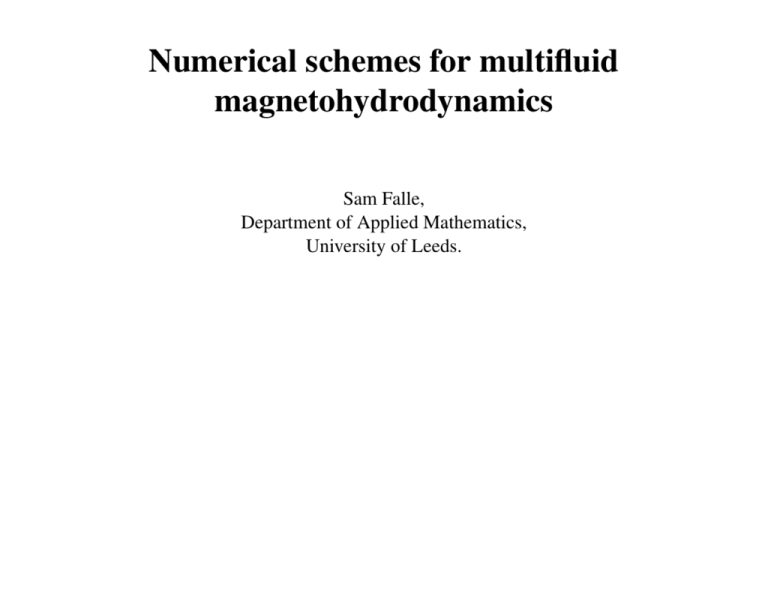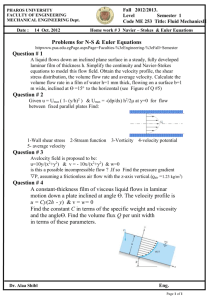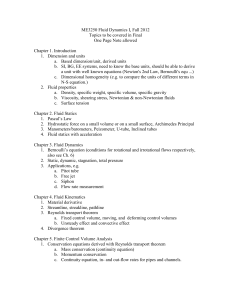Numerical schemes for multifluid magnetohydrodynamics
advertisement

Numerical schemes for multifluid magnetohydrodynamics Sam Falle, Department of Applied Mathematics, University of Leeds. Giant Molecular Clouds (GMC) e.g. Rosette Molecular Cloud Size ' 35 pc Mass ' 105 M Mean Density ' 10−22 gm cm−3 Temperature ' 10 K ⇒ sound speed ' 0.2 km s−1 Alfvén speed ' 2 km s−1 ⇒ magnetic pressure dominates Velocity dispersion ' 10 km s−1 Translucent Clumps Rosette GMC not Homogeneous: CO maps show that it consists of ' 70 clumps with Sizes ' 3.5 – 8.0 pc Masses ' 102 – 2 103 M Densities 10−21 gm cm−3 Temperature ' 10 K ⇒ Sound speed ' 0.2 km s−1 Alfvén speed ' 2 km s−1 ⇒ magnetic pressure dominates (Crutcher 1999) Velocity dispersion ' 1 km s−1 ⇒ Jeans Mass 3 103 M (based on velocity dispersion) Dense Cores These clumps also have substructure. Contain dense cores with Sizes < 1 pc Masses ' 10 – 100 M Densities ' 10−19 gm cm−3 Temperature ' 10 K ⇒ Sound speed ' 0.2 km s−1 Alfvén speed ' 2 km s−1 ⇒ magnetic pressure dominates Velocity dispersion ' 0.3 km s−1 ⇒ Jeans Mass 10 M (based on velocity dispersion) Ambipolar Diffusion (Ion–Neutral Drift) Low ionization fraction Xi (< 10−4 ) → ambipolar diffusion. Magnetic Reynolds No = 1 for 1 Length scale = 0.04 MA B 10−5 10−6 Xi 103 n 3/2 pc (MA is Alfvén Mach No ' 1) ⇒ Magnetic Reynolds number < 100 in Translucent Clumps and Dense cores ⇒ Ambipolar Diffusion important on scales smaller than GMC. Viscosity In neutral gas, Reynolds No = 1 for Length scale = 3.2 10−4 1 Mn pc (M is Mach No) Multifluid Equations N fluids with equations (i = 1 · · · N ) ∂ρi ∂ρi vix X + = Sij ∂t ∂x j6=i Sij – rate of conversion of i to j X ∂ ∂ρi vi + (ρi vix vi + pi ı̂) = αi ρi (E + vi ∧ B) + fij ∂t ∂x j6=1 fij – force exerted on i by j, αi – charge to mass ratio X ∂ei ∂ 1 + [vix ( ρi vi2 + pi )] = Hi + Gij ∂t ∂x 2 j6=i Hi – energy loss rate for i, Gij – energy transfer rate from j to i ∂B = −∇ ∧ E, ∂t ∇∧B=J= Species 1 - neutral (α1 = 0), Species 2 · · · N charged. X i αi ρi v i Force is of the form fij = Kij ρi ρj (vj − vi ) Define Hall parameter βi = αi B ρ1 Ki1 βi 1 ⇒ Species i tied to field lines βi 1 ⇒ Species i tied to neutrals in ISM β 1 for ions and electrons, but not for grains Time Dependent Numerical Scheme Two Fluid βi 1 for all i > 1 ⇒ single conducting fluid. Upwind (Godunov Type) scheme for each fluid. Add source terms. Subshocks captured in usual way. But Must have all Hall parameters βi 1 – true for ions and electrons, but not for grains. If density of conducting fluid total density ⇒ conducting fluid wavespeeds equilibrium wavespeeds ⇒ small timestep with explicit scheme Can increase mass of ions to increase timestep (Li, McKee & Klein 2006). But only works for single conducting fluid. Multi-Fluid Some species with βi ' 1 Total density of charged species total density ⇒ neglect inertia of charged species (otherwise equations are stiff) αi ρi (E + vi ∧ B) + X j6=1 fij = ∂ ∂ρi vi + (ρi vix vi + pi ı̂) ' 0 ∂t ∂x Get single fluid with induction equation ∂B = −∇ ∧ E = ∂t ∇ ∧ (v ∧ B) (J · B) B] B2 conduction parallel to field (J ∧ B) ] B Hall effect − ∇ ∧ [ν0 − ∇ ∧ [ν1 − ∇ ∧ [ν2 Here v is neutral velocity. hyperbolic (J ∧ B) ∧ B] ambipolar diffusion B2 Resistivities Conductivities are σ0 = 1 X 1 X αi ρ i 1 X αi ρi βi , σ = − αi ρi βi , σ1 = 2 B i B i (1 + βi2 ) B i (1 + βi2 ) Resistivities are ν0 = σ2 σ1 1 ν1 = − 2 ν2 = − 2 2 σ0 (σ1 + σ2 ) (σ1 + σ22 ) Note |ν1 | 1 if all βi 1 i.e. no Hall effect To compute these need charged species densities, ρi . Momentum equations for charged species reduce to βi (E + vi ∧ B) + (v1 − vi ) = 0 B i = 2···N (Neglecting inertia and collisions between charged species) Also have J=∇∧B= X αi ρi vi i These N equations determine E and the vi for i = 2 · · · N . Given the vi , determine the ρi from the continuity equations Subtleties If not isothermal, must include Lorentz force, J ∧ B as source term in momentum and energy equations to get correct relations across subshock. Hall term dispersive with ω 2 = ν12 cos2 θk 4 (θ is angle between field and x axis) i.e. phase and group velocity → ∞ as wavelength → 0 (whistler waves). Might suppose that group velocity, 2ν1 cos θk, is effective wavespeed and ∆x is smallest wavelength ∆x2 ⇒ stable timestep for explicit scheme ∆t = . 4πν1 cos θ But Obvious explicit scheme unconditionally unstable for pure Hall effect ⇒ either implicit scheme for resistive terms or differencing in O’Sullivan & Downes 2006 and super-time-stepping Algorithm 1) Calculate solution at half time using a first order scheme which is explicit for hyperbolic terms, implicit for resistive terms. 2) Use this to calculate explicit, second order accurate fluxes for both hyperbolic and resistive terms. 3) Advance solution by complete timestep using these fluxes. ⇒ scheme is second order and stability limited by hyperbolic timestep, not resistive timestep, even if Hall term is dominant. Shock Structure with Large Hall Parameters Two charged species: β2 = −5.8 106 (electrons), β3 = 5.8 103 (ions) Preshock state: Bx = 1.0, By = 0.6, Fast shock with Fast Mach No = 1.5 ν0 = 1.7 10−12 , ν1 = 10−5 , ν2 = −0.058 (Hall effect negligible) Isothermal – neutral pressure negligible. High Resolution U1 By -1.0 1.6 Fluid 1 x velocity -1.2 Transverse field 1.4 1.2 -1.4 1.0 -1.6 0.8 0.6 0.0 0.2 0.4 0.6 0.8 X 0.0 0.2 0.4 0.6 0.8 X ∆x = 5 10−3 . Line – Integration of steady equations, markers – Numerical scheme No rotation – Z component of field ' 10−4 Low Resolution U1 -1.0 Fluid 1 x velocity -1.2 -1.4 -1.6 0.0 0.2 0.4 0.6 0.8 X ∆x = 2.5 10−2 . Line – Integration of steady equations, markers – Numerical scheme Shock Structure with Strong Hall Effect Two charged species: β2 = −5.8 106 (electrons), β3 = 0.233 (grains). Preshock: Bx = 1.0, By = 0.6, Fast shock with Fast Mach No = 1.5 Preshock ν0 = 1.7 10−9 , ν1 = 0.01, ν2 = 0.0023 (Significant Hall effect) Isothermal – neutral pressure negligible. U1 High Resolution -1.0 By 1.5 -1.2 y component of field Fluid 1 x velocity -1.4 1.0 -1.6 0.5 -1.8 0.0 0.1 0.0 0.2 0.1 Bz 0.2 0.0 -0.2 z component of field -0.4 0.0 ∆x = 2 10−3 . 0.2 X X 0.1 0.2 X Line – Integration of steady equations, markers – Numerical scheme Low Resolution U1 -1.0 Fluid 1 x velocity -1.2 -1.4 -1.6 -1.8 0.0 0.1 0.2 X ∆x = 5 10−3 Line – Integration of steady equations, markers – Numerical scheme Shock Structure with Neutral Subshock Two charged species: β2 = −5.8 106 (electrons), β3 = 5.8 103 (ions) Preshock state: Bx = 1.0, By = 0.6, Fast shock with Fast Mach No = 5 ν0 = 1.7 10−12 , ν1 = 10−5 , ν2 = −0.058 (Hall effect negligible) Isothermal – neutral sound speed a = 1. By 8.0 U1 High Resolution -2.0 Fluid 1 x velocity transverse field 6.0 4.0 -4.0 2.0 -6.0 0.05 0.10 0.15 X 0.05 0.20 0.10 0.15 X U2 -2.0 Fluid 2 x velocity -4.0 -6.0 0.05 0.10 0.15 X 0.20 ∆x = 10−3 . Line – Integration of steady equations, markers – Numerical scheme 0.20 Low Resolution U1 -2.0 Fluid 1 x velocity -4.0 -6.0 0.05 0.10 0.15 X 0.20 ∆x = 5 10−3 . Line – Integration of steady equations, markers – Numerical scheme Multidimensions Resistive terms contain cross-derivatives ⇒ fully implicit scheme messy. But Can treat cross-derivatives explicitly and only use implicit approximation for diagonal terms: ∂ 2 By ∂ 2 Bx , etc ∂x2 ∂y 2 Scheme then has same stability properties as in one dimension. Cheap because just have tridiagonal matrices to invert. Can use scheme for: 1. Stability of multifluid shocks (Wardle instability) 2. Ambipolar diffusion in star forming regions. 3. Ambipolar diffusion and Hall effect in accretion discs 4. etc






